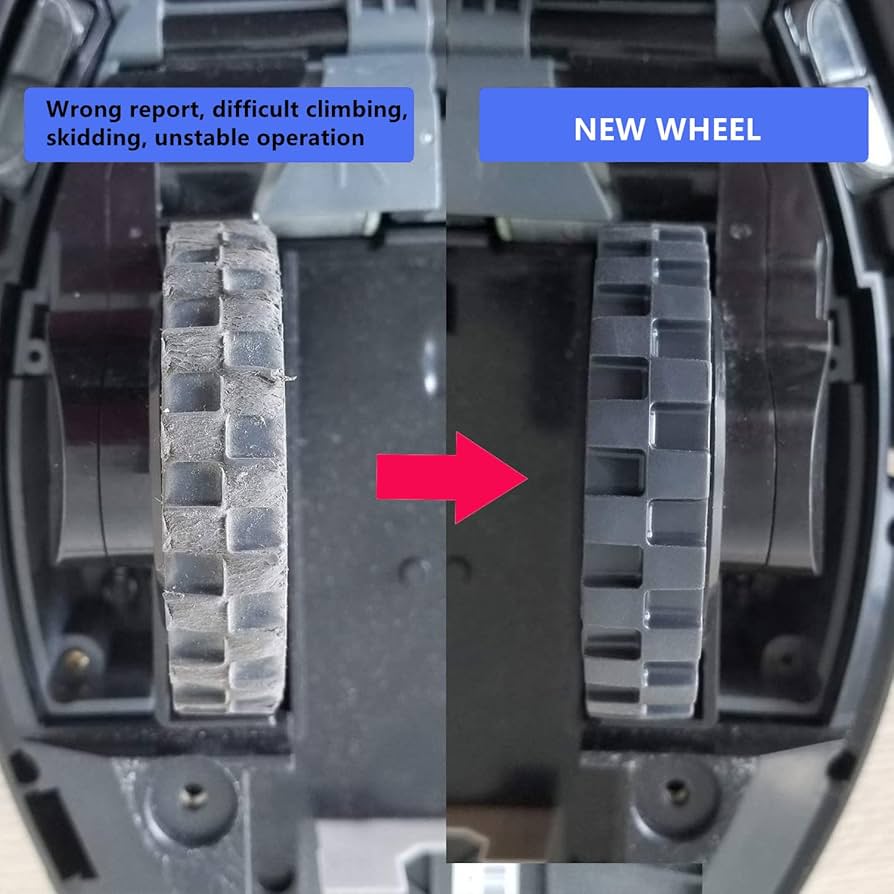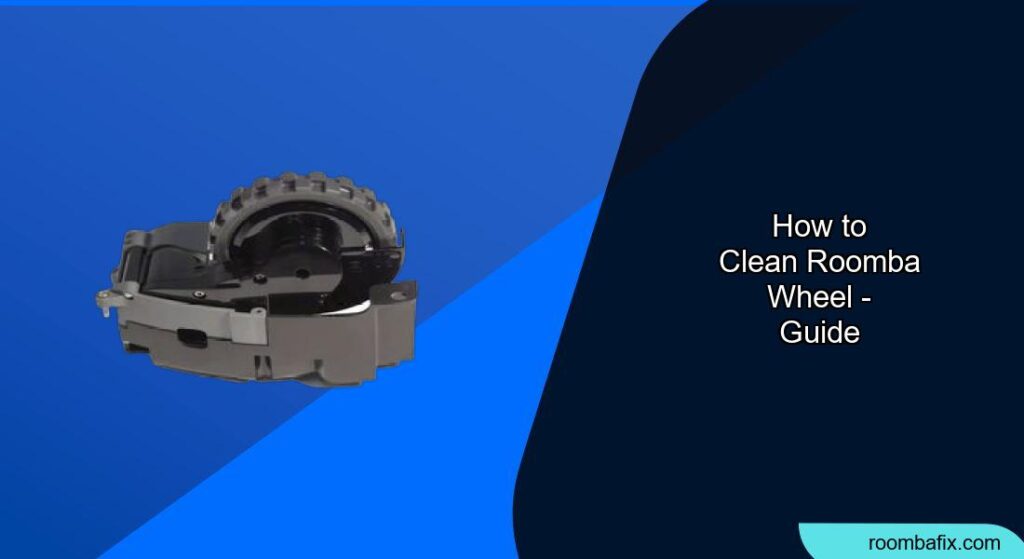Is your Roomba not performing as efficiently as it used to? Do you notice it spinning in circles, getting stuck frequently, or displaying wheel error messages? One of the most common culprits behind these issues is a buildup of hair, dust, and debris around the Roomba’s wheels. Cleaning your Roomba’s wheels is a simple yet crucial maintenance task that can significantly improve its performance and extend its lifespan.
This article provides a comprehensive guide on how to clean your Roomba’s wheels effectively. By following these steps, you can ensure your robotic vacuum continues to navigate your home smoothly and maintain its cleaning prowess. Let’s dive in and get those wheels spinning freely again!
1. Identifying the Wheels
Roomba’s have three types of wheels:
* Side Wheels: These wheels are located on the sides of the Roomba and help with overall navigation.
* Front Caster Wheel: This single wheel in the front provides balance and allows the Roomba to change direction easily.
* Main Wheels (Drive Wheels): These are the two larger wheels that provide the Roomba with traction and power to move around your home.
2. Preparation Steps Before Cleaning Roomba Wheels

Before you begin, gather the necessary tools and prepare your workspace:
- Turn off the Roomba: Ensure the Roomba is powered off to prevent any accidental operation during the cleaning process.
- Clear Workspace: Choose a well-lit, flat surface to work on. This will give you enough room to maneuver and keep track of small parts.
- Gather Cleaning Supplies: You’ll need:
- A small Phillips head screwdriver
- A thin, flathead screwdriver or a coin
- A pair of tweezers or small pliers
- A microfiber cloth or soft brush
- Isopropyl alcohol (optional, for stubborn dirt)
3. Cleaning the Side Wheels
The side wheels are prone to collecting hair and debris, which can hinder their movement. Here’s how to clean them:
- Inspect the Wheels: Check the side wheels for any visible obstructions.
- Remove Debris: Push the wheels up and down to loosen any trapped debris in the wheel well. Shake out any loose particles.
- Manual Rotation: Turn both wheels briskly by hand to ensure they move freely and exhibit the same amount of resistance.
- Compressed Air (Optional): If available, gently blow compressed air into the wheel well to dislodge any remaining debris.
- Additional Steps: If a wheel cannot be turned by hand, place the Roomba on the floor and manually push it backward and forward to help loosen any stubborn obstructions. If the wheel still doesn’t rotate smoothly after cleaning, you may need to replace it. You can check for compatible replacement wheels here on Amazon.
4. Cleaning the Front Caster Wheel
A clogged front caster wheel can cause floor damage and navigation problems. Follow these steps to clean it:
- Remove the Wheel: Firmly pull the front caster wheel to remove it from the Roomba.
- Clear the Well: Remove any debris from inside the well of the front caster wheel.
- Disassemble the Wheel (If Possible): Remove the wheel from its housing and clear any hair wrapped around the axle. Push firmly on the wheel axle to remove it completely from the wheel. Note: The axle cannot be removed from Roomba 205, 405, or 505 models.
- Wipe Clean: Wipe the wheel clean with a microfiber cloth.
- Reassemble and Reinstall: Re-install the wheel into the housing and the module back into the Roomba. Ensure the wheel clicks back into place. If the caster wheel is excessively worn or damaged, consider replacing it. You can find compatible Roomba caster wheels on Amazon.
5. Cleaning the Main Wheels (Drive Wheels)

1. Access the Wheel Module:
* Turn the Roomba upside down on a soft surface to protect the finish.
* Use a screwdriver to remove the side brush and battery cover.
* Remove the battery.
* Unscrew the screws holding the bottom cover in place. Note that some screws may not come completely out.
* Gently pull up the bottom cover to expose the Roomba’s internal components.
* Locate the wheel module that needs cleaning.
2. Remove the Wheel Module:
* Unscrew the three screws holding the wheel module in place.
* Carefully detach the wheel module from the Roomba.
3. Open the Wheel Module:
* Flip the wheel module over.
* Remove the three screws on the underside of the module.
* Carefully separate the two halves of the wheel module, being mindful of the internal components.
4. Clean the Components:
* Remove the wheel from the module.
* Remove any visible hair, dirt, or debris from the wheel, axle, and gears. Use tweezers or a small brush to remove stubborn particles.
* Wipe down all components with a clean, dry cloth. Use a slightly damp cloth for tougher stains, but ensure everything is completely dry before reassembly.
5. Reassemble the Wheel Module:
* Carefully reassemble the wheel module, ensuring all gears and components are properly aligned.
* Secure the two halves of the module with the three screws.
6. Reinstall the Wheel Module:
* Place the wheel module back into its slot in the Roomba.
* Secure the module with the three screws.
7. Reassemble the Roomba:
* Carefully reattach the bottom cover.
* Replace the screws.
* Reinstall the battery and battery cover.
* Reattach the side brush.
6. Troubleshooting Wheel Issues
Here are some common problems and solutions:
- Roomba spins in circles: This usually indicates one of the main wheels is not turning properly. Clean both main wheels and ensure they have equal resistance.
- Roomba gets stuck frequently: This can be due to a clogged front caster wheel or debris around the side wheels. Clean all wheels and check for any obstructions on the Roomba’s path.
- Roomba displays wheel error messages (e.g., Error 7, Error 10): These errors indicate a specific wheel cannot turn. Follow the cleaning steps for the affected wheel. If the problem persists, try rebooting the Roomba or removing and reinserting the wheel module.
- Wheel falling out of housing: If the front caster wheel is falling out, you may need a replacement caster wheel module.
7. Pro Tips for Roomba Wheel Maintenance
- Regular Cleaning: Clean the Roomba wheels at least once a month, or more frequently if you have pets or live in a dusty environment.
- Hair Removal: Use a seam ripper or small scissors to carefully cut away tangled hair from the wheels and axles.
- Lubrication (Optional): For squeaky wheels, apply a small amount of silicone-based lubricant to the axle after cleaning.
- Virtual Walls: Use virtual wall barriers to block off areas prone to causing the Roomba to get stuck.
8. Common Misconceptions
- “The Roomba is self-cleaning, so I don’t need to maintain it.” While Roombas are designed to minimize maintenance, regular cleaning of the wheels and other components is essential for optimal performance.
- “If the wheels look clean, they don’t need maintenance.” Even if the wheels appear clean, hair and debris can accumulate inside the wheel wells and around the axles, causing problems.
- “Any lubricant will work for squeaky wheels.” Using the wrong type of lubricant can damage the Roomba’s components. Only use silicone-based lubricants.
9. FAQ
How often should I clean my Roomba’s wheels?
For optimal performance, clean your Roomba’s wheels at least once a month. If you have pets or live in a particularly dusty environment, consider cleaning them more frequently, such as every two weeks. Regular cleaning prevents buildup that can hinder the Roomba’s movement and cleaning efficiency.
What tools do I need to clean my Roomba’s wheels?
You’ll need a few basic tools: a small Phillips head screwdriver, a thin flathead screwdriver or a coin, tweezers or small pliers, a microfiber cloth or soft brush, and optionally, isopropyl alcohol for stubborn dirt. These tools will help you disassemble, clean, and reassemble the wheels effectively.
How do I remove hair that is tightly wrapped around the wheel axles?
Use a seam ripper, small scissors, or a hook tool to carefully cut and remove the tangled hair. Be gentle to avoid damaging the axle or other components. Tweezers or small pliers can help grip and pull out the loosened hair.
What can I do to prevent my Roomba’s wheels from getting dirty quickly?
To minimize the amount of dirt and debris that accumulates around the wheels, vacuum or sweep your floors regularly before running the Roomba. Also, consider using virtual wall barriers to block off areas that are prone to causing the Roomba to get stuck or collect excessive debris.
My Roomba is still having trouble after cleaning the wheels. What else could be the issue?
If cleaning the wheels doesn’t resolve the issue, check the brushes, filters, and other components for dirt and obstructions. Also, ensure the Roomba’s sensors are clean. If problems persist, consider consulting the Roomba’s manual or contacting customer support for further assistance.
Can I use water to clean the Roomba’s wheels?
Avoid using excessive water, as it can damage the Roomba’s internal components. If necessary, use a slightly damp cloth to wipe the wheels, but ensure they are completely dry before reassembling. Isopropyl alcohol can be used for cleaning but ensure it is fully evaporated before reassembling.
10. Tips, Warnings, and Best Practices
- Safety First: Always turn off and unplug the Roomba before performing any maintenance.
- Gentle Disassembly: Be careful when disassembling the wheel modules to avoid breaking any plastic parts.
- Keep Screws Organized: Use a small container or magnetic tray to keep track of screws and small parts during disassembly.
- Avoid Harsh Cleaners: Do not use harsh chemicals or abrasive cleaners, as they can damage the Roomba’s components.
- Check for Wear and Tear: While cleaning, inspect the wheels and tires for any signs of wear and tear. Replace them if necessary.
Conclusion
Cleaning your Roomba’s wheels is an essential part of maintaining its performance and longevity. By following the steps outlined in this guide, you can easily remove accumulated dirt and debris, ensuring your Roomba continues to navigate your home efficiently and effectively.
Regular maintenance not only prevents frustrating errors and performance issues but also helps you get the most out of your investment in this handy cleaning companion. So, take a few minutes each month to clean those wheels and keep your Roomba rolling smoothly!

